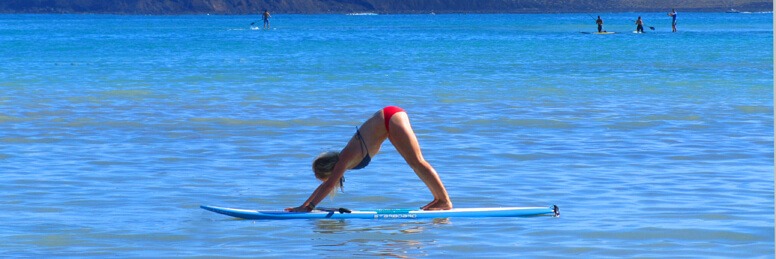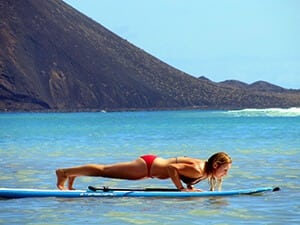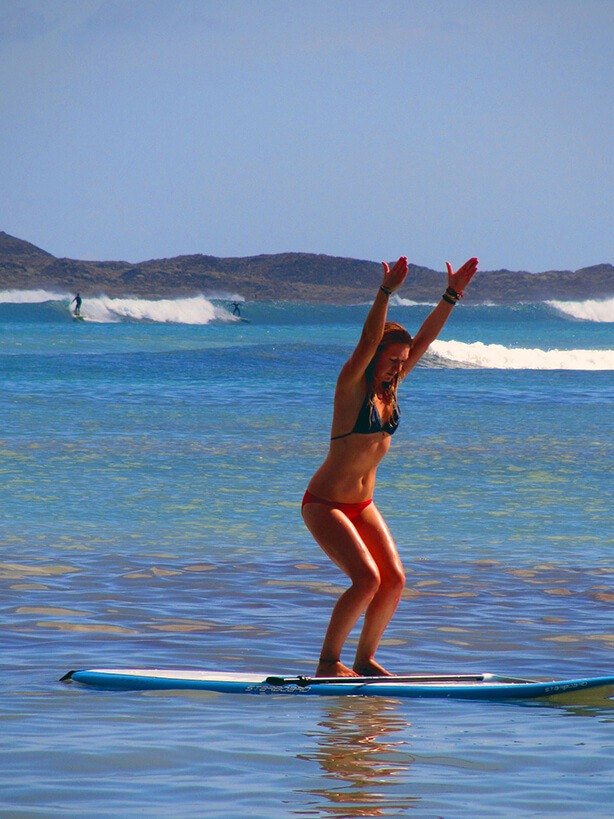That is what I love about yoga: no matter where my travels take me, with my yoga mat attached to my backpack I can make my practice part of my adventures. I have managed to find some weird and wonderful yoga spots along my travels so far, from breathtaking beaches at sunrise, balconies with snow capped mountain views, to crowded and dirty train station floors. Once I enter my practice my mat is my paradise no matter where it is laid, and what surrounds me is merely a bonus.
However, lying on the beach one day watching the stand-up paddlers out on the bay near Corralejo beach I was intrigued. They looked so at peace that day, no waves, flat, tranquil water, alone as they left the island to their own space. To me this seemed like the perfect place to take my yoga practice.

I was a beginner, first time on the board. The stand up paddle (SUP) boards are bigger than surfboards making it easier to balance. The SUP came quite naturally on that gentle September day. I paddled the board out to a spot where I could no longer hear island life, the music from the beach cafes, the voices of the children in the water, it all melted away as I chose the place that was to become my yoga studio.
It was sheer improvisation. The asanas I began with were the ones that I felt worked with me on the board. I came onto my knees and it felt very natural to flow up into adho-mukha svanasana – downward facing dog. I adjusted my position, found my centre, took a breath and as I exhaled I relaxed completely into the posture, opening my eyes to the most wonderful view.
I gazed in between my feet, where the clear blue sky had become my floor and the gentle motion of the ocean my infinite sky. My board gently floated on the surface. I could hear the water as it trickled against the board and nothing else. I was aware of nothing and everything all at once. I was so relaxed and at peace in the moment.
 I began to flow: adho-chaturanga dandasana – low plank – as I inhaled fully into ardhva-mukha svanasana – upward-facing dog – the board making soft circles on the ocean as I continued my flow back to downward facing dog.
I began to flow: adho-chaturanga dandasana – low plank – as I inhaled fully into ardhva-mukha svanasana – upward-facing dog – the board making soft circles on the ocean as I continued my flow back to downward facing dog.
The board is an unstable surface and my focus came from my centre, my core, to maintain balance through each movement. I flowed next into ajnaeyasana the low lunge pose. It took great focus and awareness on my body to hold this posture. I became fully aware of my alignment, with my connection with the board to help me find stability in the asana. Flowing into utstrasana the camel pose, where again I was able to indulge in the abstract view of the world.
Yoga on the board is extremely challenging, and a lot of fun, knowing that the ocean is there to catch you if you lose focus. The most precious moment on that first experience was my savasana, as I lay on my back, fingers skimming the water. The sun created a blanket of warmth for my body, as the welcoming breeze moved the board gently across the surface of the water, producing a calming and relaxing sensation. I allowed my eyes to softly open as I gazed into the infinite blue, being at one with the universe, working with all the elements, floating weightlessly, alone in my paradise.

SUP and yoga are complementary practices that combine to create a satisfyingly challenging experience. SUP yoga is a wonderful practice not only for the physical benefits that can be obtained, but also for the escapism, to bring balance not only to the body but also the mind.
It feels natural to find rhythm and flow with your breath when your studio is the great Atlantic, your mat the ocean surface. Fully immersed in nature, you become one with the biorhythms of the world. In this unique environment you can connect you outer and inner worlds, floating as you flow. Santosha.
About the author |
 When she isn’t studying yoga in India or exploring the world, Emma Malarkey teaches at Azul Yoga & Pilates Retreat always bringing back new inspiration for the team and guests. Her wide ranging yoga experience means her personal practice and teaching style incorporates many different styles, including traditional hatha, tantra, Mysore ashtanga, sivananda, iyengar, vinyasa, and more modern forms such as yin yoga and Bikram. When she isn’t studying yoga in India or exploring the world, Emma Malarkey teaches at Azul Yoga & Pilates Retreat always bringing back new inspiration for the team and guests. Her wide ranging yoga experience means her personal practice and teaching style incorporates many different styles, including traditional hatha, tantra, Mysore ashtanga, sivananda, iyengar, vinyasa, and more modern forms such as yin yoga and Bikram. |